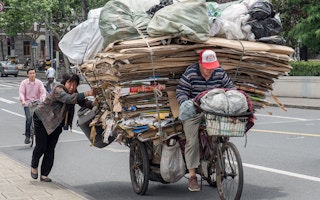In the past year waste-sorting in China has been rolled out across more cities. Shanghai introduced compulsory sorting of domestic waste in July 2019 and the Ministry of Housing and Urban Rural Development expects 46 key cities to have waste-sorting systems in place by the end of the year, with other prefecture-level cities to have it at public institutions.
On 1 September, a new revision of the Solid Waste Law enshrined the sorting of domestic waste in legislation.
Looking at how these developments have been implemented in leading cities such as Shanghai and Beijing, we can see plenty of reporting, mobilisation and online debate centred on how to ensure residents sort and deposit their waste properly – but much less on how that sorted waste is then handled.
Zhang Miao, founder of Shanghai Ecocycle, a non-governmental organisation working on waste reduction and sorting, said that data on handling still lacks transparency.
Accurate real-time data on amounts processed, handling of harmful waste and the disposal of by-products should be made available alongside the current data on waste-processing capacity and new equipment, to allow public supervision and make things run more smoothly, said Zhang.
China’s policies on waste reduction at the source have not been altered for a long time. New plastics restrictions announced in 2020, along with the update to the Solid Waste Law, may start to change that. But their efficacy depends on the implementation of “in principle” requirements and public participation.
Kitchen waste handling in trouble
One year after waste-sorting became compulsory, some methods of processing have grown disproportionally faster than others.
A first year “report card” issued on 2 July by the Shanghai municipal government showed waste-sorting at the community level has improved, with higher recycling rates and separation of kitchen and harmful waste, as well as reductions in the amount of dry waste handled.
Properly sorted waste is easier to reuse and handle safely so it doesn’t have to be bulk incinerated.
Or, at least, that’s the aim. The amount of sorted food waste that is turned into resources, like compost and biogas, and the amount of harmful waste that is made safe depends on the last link in the chain, their processing – and the report card does not cover that.
It only says that the capacity for incinerating dry waste and handling wet (food) waste is a total of 24,350 tonnes a day, without separating the figures.
But calculations based on the report card suggest almost half of the wet waste is not being properly handled: Shanghai produced 9,631 tonnes of wet waste per day in June but could only process 5,050 tonnes, leaving 4,582 tonnes unaccounted for. The report card says capacity will reach 7,000 tonnes a day, which would still come up short.
The data also shows the city has daily incineration capacity of 4,000 tonnes more than it uses, and that figure is increasing, indicating that waste handling in Shanghai favours the incineration of dry waste and overlooks the handling of wet waste.
The slow increase in kitchen waste handling capacity is partially due to purity issues due to inadequate sorting and excess salt, which makes the compost produced unsuitable for use.
Qu Ruijing, chief expert at the Recycling Commercialisation Centre at the Chinese Academy of Management Science, added that the waste gases, leachate and insects produced by decomposing plants make it difficult to site composting facilities.
Anaerobic digestion provides an alternative method for handling kitchen waste. It is broken down by bacteria in an oxygen-free container, maintained at a suitable temperature to produce methane gas that can be used for power generation.
Qu told China Dialogue that this is a more practical and scalable approach than composting, making it more popular with city bosses and the market – it is an intensive and sealed process, able to handle large quantities of waste. And as long as the methane does not leak, it is more environmentally friendly.
Qu studies the different methods for handling domestic waste. He said that Shanghai currently has seven facilities for processing kitchen waste, but these are still in trial operation or comparing wet and dry operating modes, and can only handle one-third of the city’s kitchen waste.
The kitchen waste that is not handled by these methods is disposed of locally by modular bio-digesters.
One Shanghai firm told China Dialogue its bio-digesters, which it sells to local governments and businesses, liquidise kitchen waste and can handle anywhere between a few tonnes and several hundred tonnes of waste per day and can be located and combined according to requirements.
A bio-digester can be placed by the waste-sorting bins in large apartment complexes and the resulting waste water piped to the sewers.
The market for these machines, which are mostly manufactured by small- and medium-sized enterprises and vary in quality and technology used, has expanded rapidly as kitchen waste sorting has increased.
One of these bio-digesters was involved in an incident in Hangzhou in September, when runoff from kitchen waste disposal was found to be entering the water supply.
Speaking to the Southern Weekly, one expert said there was a nationwide lack of facilities to handle kitchen waste, which have only been built in some cities.
Recycling failures
The reuse of recyclable waste is another weak point.
Qu Ruijing told China Dialogue that collecting recyclables is no longer the issue – the problem is what to do next. The sector, once dominated by countless small firms and backyard traders, has shrunk considerably, as licenses have been removed for small scale recyclers of plastics, steel, glass, paper and textiles over pollution concerns.
The loss of these recyclers meant less demand for recyclable materials and so prices plummeted in the second half of last year, although previously they had risen following the gradual halt to imports of recyclable waste from overseas.
Qu worries that the loss of capacity, low prices, and workers and business owners leaving the sector mean that recyclable materials once collected from neighbourhoods and businesses are now being left in storage.
And while smaller firms have had licences removed, larger firms don’t dare to step in. Qu said that the tax system is an obstacle. Since 2015, recycling firms have been eligible for an immediate rebate on value-added taxes paid.
But purchases of waste plastics and glass and so on are often off the books, making it impossible to claim rebates on input VAT. According to Qu, the big firms who have tried to work in the sector have been left battered.
Nonetheless, Qu is hopeful that the revised Solid Waste Law will improve matters because it adds articles on preferential tax policies for recyclers.
Too much incineration
Meanwhile, there has been an over-expansion of incineration capacity.
Sifting out kitchen waste reduces the moisture content of mixed waste, making incineration more economical and environmentally friendly. It also helps reduce the amount of waste sent for incineration. Despite this, China has built numerous incineration facilities over the last decade.
At a June press conference, Zhao Yingmin, vice minister at the Ministry of Ecology and Environment (MEE), revealed at a press conference that incineration capacity had increased 303 per cent over the previous decade, with an 86 per cent increase in the number of all different types of domestic waste processing facilities.
Incineration has dominated the increase in waste processing capacity. Calculations in a report from the Rock Environment and Energy Institute (REEI) put the proportion of incineration capacity in total waste processing in 2020 at 57.5 per cent – more than the 13th Five Year Plan target of 54 per cent.
According to the institute’s figures, the number of incineration plants in China has rocketed from 104 to 455 over the last 10 years, but those plants have only been in operation for an average of 280 days a year, indicating overcapacity. And if average days of operation were increased to 320 days a year, 63 of these plants, each with daily capacity of 1100 tonnes, would have been unnecessary.
According to the REEI, subsidies for electricity generated by waste-to-power plants incentivised construction of excess capacity. It argues that power generated from waste burning worsens air pollution and undercuts efforts to reuse waste or reduce waste at source.
Harmful waste overlooked
The least attention of all is given to “harmful waste”, which includes pharmaceuticals, fluorescent light tubes, batteries and paint, and there is a particular lack of transparency here.
In a survey of 97 Shanghai neighbourhoods carried out by Zhang Miao’s research team between September and December last year, 14 did not have receptacles for harmful waste.
Ten more were not operating up to standard: mercury-containing tubes were often being broken, water was gathering in receptacles, and so on. This risks pollution being created during the collection process.
They also found a lack of clarity over the credentials of the firms collecting the harmful waste, meaning a lack of effective oversight during transportation and storage.
There are currently no technical standards for the collection, transportation and storage of this waste, meaning badly run operations could cause pollution or safety incidents.
Also, Shanghai charges for disposal of harmful waste over certain quantities (30 fluorescent bulbs and 5kg of other harmful waste per collection point), giving people an incentive to mix that waste in with other waste, reducing sorting.
Reducing waste at the source
In 2014, the MEE started releasing data on how much domestic waste 200 of China’s medium- and large-sized cities produced. The figures have increased annually, reaching a total of 211 million tonnes in 2018.
Reduction of domestic waste at the source is lacking: policies are failing to keep up with circumstances and existing policies are not having the desired outcomes.
However, in January the National Development and Reform Commission and the MEE published a document on tougher management of plastic pollution, described as a “new plastics restriction order”.
This covers far more products than the original 2008 restrictions, expanding its scope beyond plastic shopping bags to provide a timetable for the restriction and banning of production, sale and use of a range of plastic products between 2020 and 2025.
The new Solid Waste Law, which came into force on 1 September, also had plenty of rules on plastics, requiring both online and offline retailers, delivery firms and takeaway food sellers to report their use and recycling of single-use plastics every year.
On waste reduction, the law puts forward the idea of “household waste producer responsibility” – reduction at source and sorting are the responsibility of organisations, households and individuals producing the waste, and a “producer pays” model to fund processing.
The report from REEI mentioned earlier also proposed a payment model reflecting actual costs, which would reduce production of waste at source and replace existing perverse incentives.
The revision of the law also introduces an extended producer responsibility system for the first time, requiring the manufacturers of appliances, electronics, lead batteries and EV batteries to set up recycling systems to recycle and reuse their old products. Environmentalists complain the scope of the system is too narrow.
It’s also worth noting that the new plastics ban and the revision of the Solid Waste Law both call for replacing plastic with biodegradable materials.
In another Southern Weekly article several experts warned that biodegradable materials do not degrade easily using conventional techniques and are hard to sort from ordinary plastics.
More importantly, they worry these materials may reduce the attention paid to waste reduction and extend a culture of disposable consumption, despite not yet offering a truly sustainable alternative. This may make reducing plastic waste at the source more complicated.
This article was originally published on China Dialogue under a Creative Commons licence.












